
Table 1. Showing the mean difference between the male and female students on emotional intelligence scale
The main purpose of the paper was to find out the emotional intelligence of the students of fawn)/ of education of the Islamia University of Bahawalpur. In order to get the desire end Wong & Law emotional intelligence scale (WLIS) was used after some amendments according to culture and environment, the scale was pilot tested and the reliability of the scale was 0.808 (Cronbach's Alpha). There are six departments in faculty of education, 300 students of master level, 50 each from each department was considered as sample of the study. After getting the data the data was tabulated and analyzed by using (SPSS XII) in terms of mean, independent sample t-test and one wayANOVA. The study reveals that Mere is no significant difference between the scores of male and female students. The students from Geography department having the highest score and the students from Psychology department having the lowest score. The score of the Geography department is significantly better than the scores of Psychology department and Social work department, while there is no significant difference among other departments. There is no significant difference between the scores of science graduates and arts graduates on WLIS.The students having the age group 27-29 years having the highest score, while the students having the age group of 20-23 years having the lowest score and Mere is no significant difference among the students on variable of age. The study shows that age is directly proportional to the scores on WLIS. The study leads to several conclusions and recommendations.
Emotional intelligence (El) refers to the ability to perceive, control, and evaluate emotions. Some researchers suggest that emotional intelligence can be learned and strengthened, while other claim it is an inborn characteristic.
Since 1990, Peter Salovey and John D. Mayer have been the leading researchers on emotional intelligence. In their influential article "Emotional Intelligence", they defined emotional intelligence as, "the subset of social intelligence that involves the ability to monitor one's own and others' feelings and emotions, to discriminate among them and to use this information to guide one's thinking and actions" 1990.
Salovey and Mayer proposed a model that identified four different factors of emotional intelligence: the perception of emotion, the ability reason using emotions, the ability to understand emotion, and the ability to manage emotions.
According to Salovey and Mayer, the four branches of their model are, "arranged from more basic psychological processes to higher, more psychologically integrated processes. For example, the lowest level branch concerns the (relatively) simple abilities of perceiving and expressing emotion. In contrast, the highest level branch concerns the conscious, reflective regulation of emotion" (1997).
Effective management of emotions is an important aspect of behavior. Recent investigations in the field of personality indicate that emotional maturity and social skills, along with intelligence, bring adjustment and success in one's life. An emotionally intelligent person can manage his/her feelings in a better way and cope with stresses, with the effective ability to solve problems. It is said that an emotionally intelligent person is the one who is capable of managing ones feelings and emotions in various aspects of one life. Such a person, consequently, is well adjusted and are more successful in various areas of educational and other professional fields.
Emotional intelligence has been found as a reliable predictor of academic achievement than general intelligence. A large amount of research work done in the last century concluded that the higher the intelligence the better the academic performance. The results of different researches indicated that emotions, being the most significant and influential component of personality, extremely plays an important role in ones well being. These are emotions, which help us to make important decisions of our life. Emotions facilitate our attitude and behavior towards the attainment of our goals. For instance, joy at getting “A" grade in the subject of English and then later deciding to pursue a Master degree in the same subject. Therefore, it can be said that healthy emotions give clarity in perception, thinking and analyzing every day life situations.
On the other hand, emotions can negatively impact ones behavior if they are not dealt properly or they remain unfulfilled. Unfulfilled emotions tend to adversely affect the creativity and success of pupils. Further more, unhealthy emotional state also leads to the development of different psychological problems, which significantly influences one's personal, social and occupational life.
According to Simon (1967) emotions have a central role in human psyche and they have profound influence on one's thoughts, perceptions and behaviors. Thus, it is appropriate to say that emotions are the essential motivating force behind all the psychological activities. These make life more meaningful, colorful and tasteful. These energize the individual physiologically, force attention towards events and objects that are particularly relevant to well being and induce action. According to Wallbolt and Scherer (1989) there are five components, which are involved in the experience of emotions: evaluation of situation, physiological changes, motor expression, motivation for action and subjective feeling state. Spector and Goh (2001) suggested that individuals are active agents at their own experience who monitor and evaluate the environment and take actions that are deemed appropriate for the situation.
According to Bower (1981) emotions are the result of evaluation of internal and external pieces of information. These basically arise and change in response to a person's interaction with his /her environment, where as according to Fredrickson (2000) emotions are multi component response tendencies that unfold over a relatively short time span. An emotional process begins with an individual's assessment of the personal meaning of some antecedent event and in the views of Lazarus (1991) this process is “personal environment relationship" or “adaptational encounter". This appraisal process triggers a flow of response tendencies, which may be manifested across loosely coupled component systems, such as subjective experience, facial expressions and physiological changes. Emotions differ from moods.
According to Mayer & Salovey (1997) and Salovey & Mayer (1990) emotional intelligence refers to an ability to perceive and recognize emotions, to assimilate emotions, to understand the message and meaning of the emotions. Emotional intelligence is the ability of managing and regulating emotions.
Goleman (1998) describes emotional intelligence as "managing feelings so that they are expressed appropriately and effectively, enabling people to work together smoothly toward their common goals." According to Goleman, the four major skills that make up emotional intelligence are:
According to Mayer and Salovey (1997b) emotional intelligence reflects not a single trait or ability but, rather a composite of distinct emotional reasoning abilities: perceiving, understanding and regulating emotions.
Perceiving emotions consists of recognizing and interpreting the meaning of various emotional states, as well as their relations to other sensory experiences. Understanding emotions involves comprehension of how basic emotions are blended to form complex emotions, how emotions are affected by events surrounding experiences and whether various emotional reactions are likely in given social settings. Regulating emotions encompasses the control of emotions in oneself and in others. An individual's emotional intelligence is an indication of how he or she perceives, understands and regulates emotions. According to Salovey and Mayer (1990b) as a whole, emotional intelligence is a form of intelligence that involves “the ability to monitor one's own and others’ feelings and emotions, to discriminate among them and to use these information to guide one's thinking and actions”.
It can be concluded that different people have different abilities regarding the management and regulation of emotions. An emotionally intelligent person would be the one who acknowledges emotions in himself /herself, has an ability to express them appropriately in given social context, understands and accepts others emotions, have an ability to maintain fruitful relationships with others. He /she has positive self image, handles stressful situations wisely and knows how ones emotions affects thinking and behavior. Such a person has an accurate perception of ones own and others emotions. Emotional intelligence is knowing when and how to express emotions as it does with controlling it.
This study was based on the following objectives:
1. To describe the emotional intelligence and its importance
2. To compare the scores of students on emotional intelligence scale gender wise, qualification wise, age wise and department wise.
3. To suggest some measures and recommendations.
The population of the study consisted of all the students of Master degree level of The lslamia University of Bahawalpur. 50 students each from all the six department of faculty of education were considered as the sample of the study.
Since the study was descriptive in nature, therefore, survey approach was considered appropriate to collect the data. For the purpose, Wong & Law emotional intelligence scale (WLlS) was used after some amendments according to culture and environment, the scale was pilot tested and the reliability of the scale was 0.808 (Cronbach's Alpha).
The finalized emotional intelligence scale was administered on students personally.
To analyze the data, students’ responses were converted into numerical scale. SPSS XII was used to analyze the data. Mean scores was calculated and then independent ‘t’ -test and ANOVA was run in order to find the significant difference between the mean scores of students on emotional intelligence scale on the selected variables of all the departments of the faculty of education, the lslamia university of Bahawalpur.
Data collected through the emotional intelligence scale was analyzed in terms of mean score, independent sample ‘t’ -test and ANOVA. The findings drawn out from the data analysis are given below.
Table 1 shows that the mean score of male respondents is higher, but when it was compared with female at 0.05 significant level, the ‘t’-value obtained is less than 1.96 and p-value is greater than 0.05, so it is found that the mean score of male respondents is higher but that difference is not significant. It is concluded from Table 1 that both male and female respondents are having the same mean score an emotional intelligence scale.

Table 1. Showing the mean difference between the male and female students on emotional intelligence scale
Table 2 shows that the department of Geography is having the highest score which is 77.90, then Education department with mean score of 75.84, then Department of Fine arts with 74.52, then Department of Educational Training with 72.36, then Department of Social Work with 72.24 and at the end is the Department of Psychology with mean score of 70. 72. It is concluded from the Table 2 and Figure 1. that highest mean score is 77.90 in favor of Department of Geography and lowest mean score is 70.72 in favor of Department of Psychology.
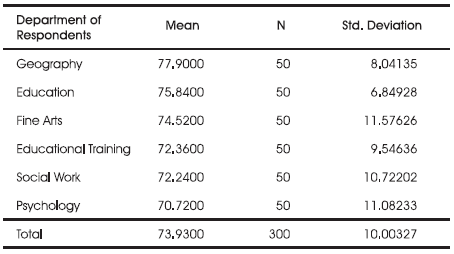
Table 2. Showing the mean score on Emotional Intelligence scale department wise in descending order
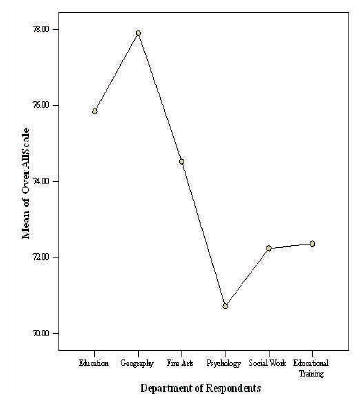
Figure 1. Showing the mean plots of mean scores of departments on Emotional Intelligence scale
It is evident from Table 3 that F-value is high and p-value is less than 0.05. This shows that there is a significant difference among the departments an emotional intelligence scale. So it is decided to run POST HOC multiple comparisons.

Table 3. Showing the ANOVA on over all mean scores of Departments on Emotional Intelligence scale
Table 4 shows that Department of Geography is significantly better than Departments of Psychology and Social work. So it is concluded that Department of Geography is significantly better and Department of Psychology is significantly lower among the departments an emotional intelligence scale.

Table 4. Showing the multiple comparison among the Department on Emotional Intelligence scale
Table 5 shows that when multiple comparisons POST HOC tukey test was run, it produced two sub sets, according to these sub sets there is no significant difference among educational training, fine arts, education and geography and there is no significant difference among psychology, social work, educational training, fine arts and education. On the other hand geography is significantly better than psychology and social work.
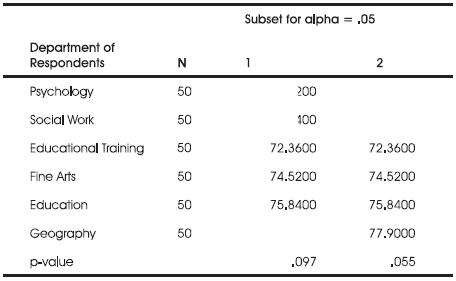
Table 5. Showing the subsets on multiple compassions among the Department
It is evident from Table 6 that the mean score of science graduates is higher. but when it was compared with arts graduates at 0.05 significant level, the ‘t’-value obtained is less than 1 .96 and p-value is greater than 0.05, so it is found that the mean score of science graduates is higher but that difference is not significant. From Table 6 and Figure 2 it is concluded that both science and arts graduates are having the same mean score on emotional intelligence scale.

Table 6. Showing the mean difference between science graduates and arts graduate on Emotional Intelligence scale
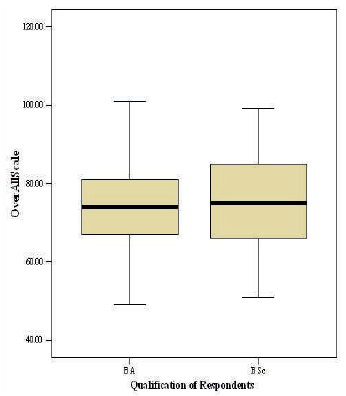
Figure 2. Showing the box plot of mean score on Emotional Intelligence qualification wise
Table 7 shows that respondents having the age group 27- 29 years are having the highest mean score, than the age group 24-26 years and 20-23 years age group. From the Table 7 and the Figures 3 and 4, it can be concluded that emotional intelligence increased with age and it is directly proportional to the age.

Table 7. Showing the mean score of respondents age wise on Emotional Intelligence scale in descending order
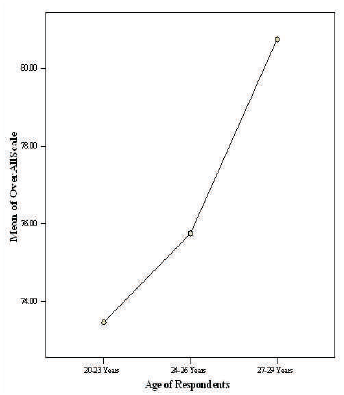
Figure 3. Showing plots of mean scores of respondents age wise on Emotional Intelligence scale
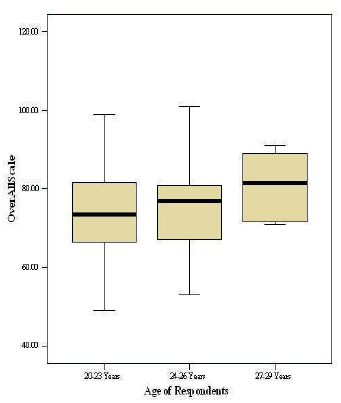
Figure 4. Showing the box plot of mean scores on Emotional Intelligence scale age wise
It is evident from the Table 8 that F-value is low and p-value is greater than 0.05. This shows that there is no significant difference among the respondents age wise on emotional intelligence scale.

Table 8. Showing the ANOVA on over all mean scores of respondents age wise on Emotional Intelligence scale
| Name | |||
| Gender | Male | Female | |
| Department | |||
| Age | 20-23 | 24-26 | 27-29 |
| Qualification | B.A | B.Sc | |
| Faculty |